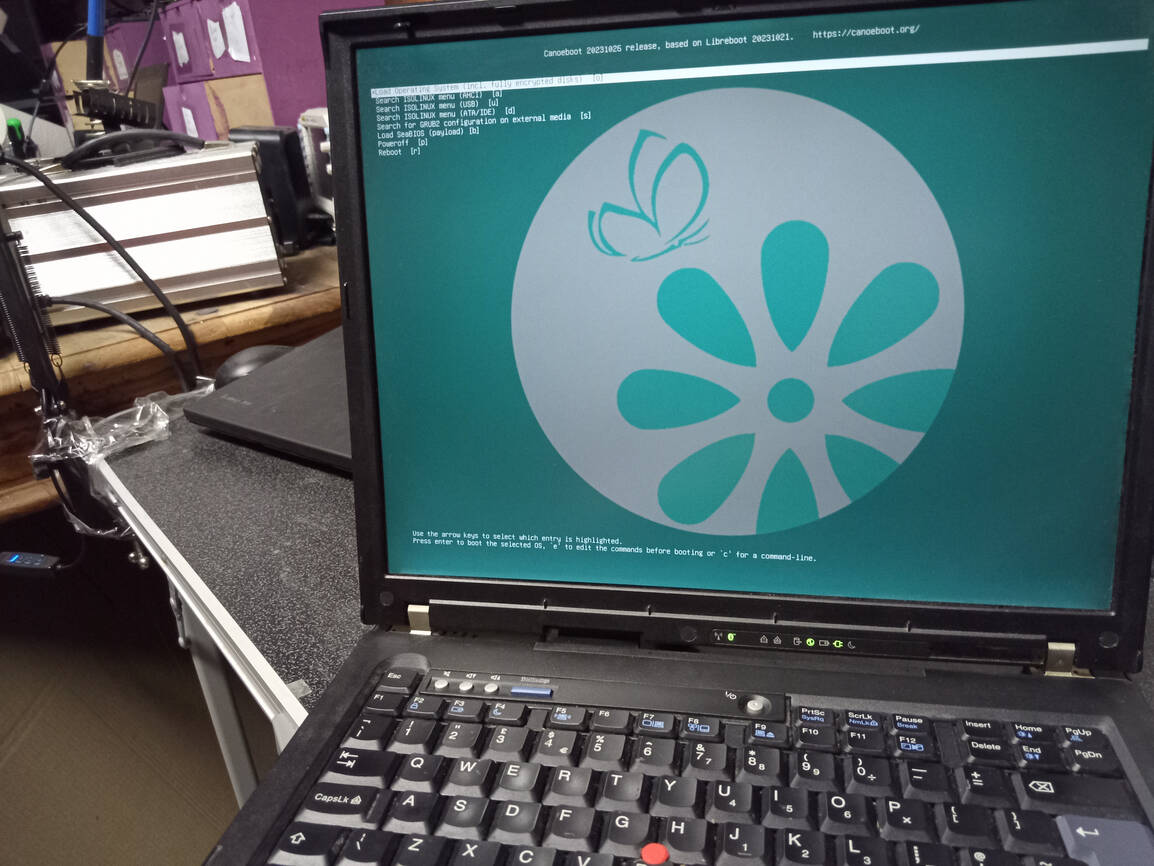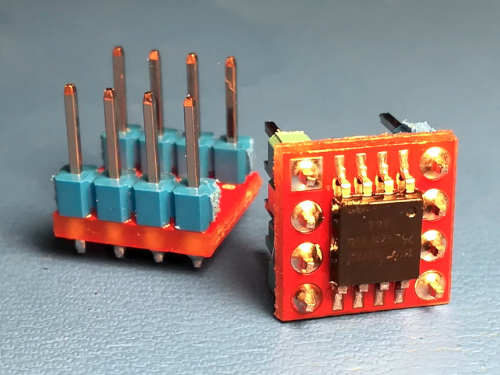---
title: Canoeboot project
x-toc-enable: true
...
The *Canoeboot* project provides
[free](https://writefreesoftware.org/learn) (*libre*) boot
firmware based on coreboot, replacing proprietary BIOS/UEFI firmware
on [specific Intel/AMD x86 and ARM based motherboards](docs/hardware/),
including laptop and desktop computers. It initialises the hardware (e.g. memory
controller, CPU, peripherals) and starts a bootloader for your operating
system. [GNU+Linux](docs/gnulinux/) and [BSD](docs/bsd/) are well-supported. Help is
available via [\#canoeboot](https://web.libera.chat/#canoeboot)
on [Libera](https://libera.chat/) IRC.

 **NEW RELEASE: The latest release is Canoeboot 20240612, released
on 12 June 2024.
See: [Canoeboot 20240612 release announcement](news/canoeboot20240612.md).**
Why should you use *Canoeboot*?
----------------------------
Canoeboot gives you [freedoms](https://writefreesoftware.org/learn) that
you otherwise can't get with most other boot firmware, plus faster boot speeds
and [better security](docs/gnulinux/grub_hardening.md). It's extremely powerful
and [configurable](docs/maintain/) for many use cases. Canoeboot is a *special
fork* of Libreboot, maintained in parallel to it by the same developer (Leah
Rowe); Canoeboot complies with the GNU Free System Distribution Guidelines,
ensuring that everything in the boot flash is *free software*. *Canoeboot* only
supports a very limited subset of hardware from coreboot that is known to boot
without binary blobs. Many other boards in coreboot require binary blobs for
things like memory controller initialisation. Canoeboot *removes* binary blobs
from coreboot and U-Boot, which are then provided "de-blobbed" in releases.
*We* believe the freedom to [study, share, modify and use
software](https://writefreesoftware.org/), without any
restriction, is one of the fundamental human rights that everyone must have.
In this context, *software freedom* matters. Your freedom matters. Education
matters.
[Right to repair](https://en.wikipedia.org/wiki/Right_to_repair) matters.
Many people use proprietary (non-libre)
boot firmware, even if they use a fully free GNU+Linux distribution.
Proprietary firmware often [contains](faq.html#intel) [backdoors](faq.html#amd),
and can be buggy. The Canoeboot project was founded in October 2023, with the
express purpose of making coreboot firmware accessible for non-technical users.
The Canoeboot project uses [coreboot](https://www.coreboot.org/) for [hardware
initialisation](https://doc.coreboot.org/getting_started/architecture.html).
Coreboot is notoriously difficult to install for most non-technical users; it
handles only basic initialization and jumps to a separate
[payload](https://doc.coreboot.org/payloads.html) program (e.g.
[GRUB](https://www.gnu.org/software/grub/),
[Tianocore](https://www.tianocore.org/)), which must also be configured.
*Canoeboot solves this problem*; it is a *coreboot distribution* with
an [automated build system](docs/build/) that builds complete *ROM images*, for
more robust installation. Documentation is provided.
Canoeboot is not a fork of coreboot
-----------------------------------
**NEW RELEASE: The latest release is Canoeboot 20240612, released
on 12 June 2024.
See: [Canoeboot 20240612 release announcement](news/canoeboot20240612.md).**
Why should you use *Canoeboot*?
----------------------------
Canoeboot gives you [freedoms](https://writefreesoftware.org/learn) that
you otherwise can't get with most other boot firmware, plus faster boot speeds
and [better security](docs/gnulinux/grub_hardening.md). It's extremely powerful
and [configurable](docs/maintain/) for many use cases. Canoeboot is a *special
fork* of Libreboot, maintained in parallel to it by the same developer (Leah
Rowe); Canoeboot complies with the GNU Free System Distribution Guidelines,
ensuring that everything in the boot flash is *free software*. *Canoeboot* only
supports a very limited subset of hardware from coreboot that is known to boot
without binary blobs. Many other boards in coreboot require binary blobs for
things like memory controller initialisation. Canoeboot *removes* binary blobs
from coreboot and U-Boot, which are then provided "de-blobbed" in releases.
*We* believe the freedom to [study, share, modify and use
software](https://writefreesoftware.org/), without any
restriction, is one of the fundamental human rights that everyone must have.
In this context, *software freedom* matters. Your freedom matters. Education
matters.
[Right to repair](https://en.wikipedia.org/wiki/Right_to_repair) matters.
Many people use proprietary (non-libre)
boot firmware, even if they use a fully free GNU+Linux distribution.
Proprietary firmware often [contains](faq.html#intel) [backdoors](faq.html#amd),
and can be buggy. The Canoeboot project was founded in October 2023, with the
express purpose of making coreboot firmware accessible for non-technical users.
The Canoeboot project uses [coreboot](https://www.coreboot.org/) for [hardware
initialisation](https://doc.coreboot.org/getting_started/architecture.html).
Coreboot is notoriously difficult to install for most non-technical users; it
handles only basic initialization and jumps to a separate
[payload](https://doc.coreboot.org/payloads.html) program (e.g.
[GRUB](https://www.gnu.org/software/grub/),
[Tianocore](https://www.tianocore.org/)), which must also be configured.
*Canoeboot solves this problem*; it is a *coreboot distribution* with
an [automated build system](docs/build/) that builds complete *ROM images*, for
more robust installation. Documentation is provided.
Canoeboot is not a fork of coreboot
-----------------------------------

 In fact, Canoeboot tries to stay as close to *stock* coreboot as possible,
for each board, but with many different types of configuration provided
automatically by the Canoeboot build system.
In the same way that *Trisquel* is a *GNU+Linux distribution*, Canoeboot is
a *coreboot distribution*. If you want to build a ROM image from scratch, you
otherwise have to perform expert-level configuration of coreboot, GRUB and
whatever other software you need, to prepare the ROM image. With *Canoeboot*,
you can literally download from Git or a source archive, and run `make`, and it
will build entire ROM images. An automated build system, named `cbmk`
(CanoeBoot MaKe), builds these ROM images automatically, without any user input
or intervention required. Configuration has already been performed in advance.
If you were to build regular coreboot, without using Canoeboot's automated
build system, it would require a lot more intervention and decent technical
knowledge to produce a working configuration.
Regular binary releases of Canoeboot provide these
ROM images pre-compiled, and you can simply install them, with no special
knowledge or skill except the ability to
follow [simplified instructions, written for non-technical
users](docs/install/).
In fact, Canoeboot tries to stay as close to *stock* coreboot as possible,
for each board, but with many different types of configuration provided
automatically by the Canoeboot build system.
In the same way that *Trisquel* is a *GNU+Linux distribution*, Canoeboot is
a *coreboot distribution*. If you want to build a ROM image from scratch, you
otherwise have to perform expert-level configuration of coreboot, GRUB and
whatever other software you need, to prepare the ROM image. With *Canoeboot*,
you can literally download from Git or a source archive, and run `make`, and it
will build entire ROM images. An automated build system, named `cbmk`
(CanoeBoot MaKe), builds these ROM images automatically, without any user input
or intervention required. Configuration has already been performed in advance.
If you were to build regular coreboot, without using Canoeboot's automated
build system, it would require a lot more intervention and decent technical
knowledge to produce a working configuration.
Regular binary releases of Canoeboot provide these
ROM images pre-compiled, and you can simply install them, with no special
knowledge or skill except the ability to
follow [simplified instructions, written for non-technical
users](docs/install/).


 **NEW RELEASE: The latest release is Canoeboot 20240612, released
on 12 June 2024.
See: [Canoeboot 20240612 release announcement](news/canoeboot20240612.md).**
Why should you use *Canoeboot*?
----------------------------
Canoeboot gives you [freedoms](https://writefreesoftware.org/learn) that
you otherwise can't get with most other boot firmware, plus faster boot speeds
and [better security](docs/gnulinux/grub_hardening.md). It's extremely powerful
and [configurable](docs/maintain/) for many use cases. Canoeboot is a *special
fork* of Libreboot, maintained in parallel to it by the same developer (Leah
Rowe); Canoeboot complies with the GNU Free System Distribution Guidelines,
ensuring that everything in the boot flash is *free software*. *Canoeboot* only
supports a very limited subset of hardware from coreboot that is known to boot
without binary blobs. Many other boards in coreboot require binary blobs for
things like memory controller initialisation. Canoeboot *removes* binary blobs
from coreboot and U-Boot, which are then provided "de-blobbed" in releases.
*We* believe the freedom to [study, share, modify and use
software](https://writefreesoftware.org/), without any
restriction, is one of the fundamental human rights that everyone must have.
In this context, *software freedom* matters. Your freedom matters. Education
matters.
[Right to repair](https://en.wikipedia.org/wiki/Right_to_repair) matters.
Many people use proprietary (non-libre)
boot firmware, even if they use a fully free GNU+Linux distribution.
Proprietary firmware often [contains](faq.html#intel) [backdoors](faq.html#amd),
and can be buggy. The Canoeboot project was founded in October 2023, with the
express purpose of making coreboot firmware accessible for non-technical users.
The Canoeboot project uses [coreboot](https://www.coreboot.org/) for [hardware
initialisation](https://doc.coreboot.org/getting_started/architecture.html).
Coreboot is notoriously difficult to install for most non-technical users; it
handles only basic initialization and jumps to a separate
[payload](https://doc.coreboot.org/payloads.html) program (e.g.
[GRUB](https://www.gnu.org/software/grub/),
[Tianocore](https://www.tianocore.org/)), which must also be configured.
*Canoeboot solves this problem*; it is a *coreboot distribution* with
an [automated build system](docs/build/) that builds complete *ROM images*, for
more robust installation. Documentation is provided.
Canoeboot is not a fork of coreboot
-----------------------------------
**NEW RELEASE: The latest release is Canoeboot 20240612, released
on 12 June 2024.
See: [Canoeboot 20240612 release announcement](news/canoeboot20240612.md).**
Why should you use *Canoeboot*?
----------------------------
Canoeboot gives you [freedoms](https://writefreesoftware.org/learn) that
you otherwise can't get with most other boot firmware, plus faster boot speeds
and [better security](docs/gnulinux/grub_hardening.md). It's extremely powerful
and [configurable](docs/maintain/) for many use cases. Canoeboot is a *special
fork* of Libreboot, maintained in parallel to it by the same developer (Leah
Rowe); Canoeboot complies with the GNU Free System Distribution Guidelines,
ensuring that everything in the boot flash is *free software*. *Canoeboot* only
supports a very limited subset of hardware from coreboot that is known to boot
without binary blobs. Many other boards in coreboot require binary blobs for
things like memory controller initialisation. Canoeboot *removes* binary blobs
from coreboot and U-Boot, which are then provided "de-blobbed" in releases.
*We* believe the freedom to [study, share, modify and use
software](https://writefreesoftware.org/), without any
restriction, is one of the fundamental human rights that everyone must have.
In this context, *software freedom* matters. Your freedom matters. Education
matters.
[Right to repair](https://en.wikipedia.org/wiki/Right_to_repair) matters.
Many people use proprietary (non-libre)
boot firmware, even if they use a fully free GNU+Linux distribution.
Proprietary firmware often [contains](faq.html#intel) [backdoors](faq.html#amd),
and can be buggy. The Canoeboot project was founded in October 2023, with the
express purpose of making coreboot firmware accessible for non-technical users.
The Canoeboot project uses [coreboot](https://www.coreboot.org/) for [hardware
initialisation](https://doc.coreboot.org/getting_started/architecture.html).
Coreboot is notoriously difficult to install for most non-technical users; it
handles only basic initialization and jumps to a separate
[payload](https://doc.coreboot.org/payloads.html) program (e.g.
[GRUB](https://www.gnu.org/software/grub/),
[Tianocore](https://www.tianocore.org/)), which must also be configured.
*Canoeboot solves this problem*; it is a *coreboot distribution* with
an [automated build system](docs/build/) that builds complete *ROM images*, for
more robust installation. Documentation is provided.
Canoeboot is not a fork of coreboot
-----------------------------------

 In fact, Canoeboot tries to stay as close to *stock* coreboot as possible,
for each board, but with many different types of configuration provided
automatically by the Canoeboot build system.
In the same way that *Trisquel* is a *GNU+Linux distribution*, Canoeboot is
a *coreboot distribution*. If you want to build a ROM image from scratch, you
otherwise have to perform expert-level configuration of coreboot, GRUB and
whatever other software you need, to prepare the ROM image. With *Canoeboot*,
you can literally download from Git or a source archive, and run `make`, and it
will build entire ROM images. An automated build system, named `cbmk`
(CanoeBoot MaKe), builds these ROM images automatically, without any user input
or intervention required. Configuration has already been performed in advance.
If you were to build regular coreboot, without using Canoeboot's automated
build system, it would require a lot more intervention and decent technical
knowledge to produce a working configuration.
Regular binary releases of Canoeboot provide these
ROM images pre-compiled, and you can simply install them, with no special
knowledge or skill except the ability to
follow [simplified instructions, written for non-technical
users](docs/install/).
In fact, Canoeboot tries to stay as close to *stock* coreboot as possible,
for each board, but with many different types of configuration provided
automatically by the Canoeboot build system.
In the same way that *Trisquel* is a *GNU+Linux distribution*, Canoeboot is
a *coreboot distribution*. If you want to build a ROM image from scratch, you
otherwise have to perform expert-level configuration of coreboot, GRUB and
whatever other software you need, to prepare the ROM image. With *Canoeboot*,
you can literally download from Git or a source archive, and run `make`, and it
will build entire ROM images. An automated build system, named `cbmk`
(CanoeBoot MaKe), builds these ROM images automatically, without any user input
or intervention required. Configuration has already been performed in advance.
If you were to build regular coreboot, without using Canoeboot's automated
build system, it would require a lot more intervention and decent technical
knowledge to produce a working configuration.
Regular binary releases of Canoeboot provide these
ROM images pre-compiled, and you can simply install them, with no special
knowledge or skill except the ability to
follow [simplified instructions, written for non-technical
users](docs/install/).